You’re gazing at your green pool, wondering where to start. Don’t fret! This guide will empower you with all you need to know about transforming that unsightly algae-filled mess back into a sparkling oasis.
You’ll learn the causes, preparation steps, cleaning process, and maintenance tips for your pool.
Let’s get started on reclaiming your backyard paradise from those pesky algae invaders!
Understanding the Causes of a Green Pool
Before we can tackle cleaning, it’s crucial to understand what’s turning your pool green in the first place. The usual culprit is algae, tiny organisms that thrive in water and sunlight. Under ideal conditions, they multiply rapidly, creating a bloom that turns your pool from inviting blue to unattractive green.
Algae types identification is essential for effective remediation. Most common is green algae, but you may also encounter mustard (yellow) or black algae. Each type requires a different approach for removal and prevention.

Another key factor in maintaining a clear pool is understanding your pool’s pH importance. A balanced pH level prevents algae growth by keeping the water too acidic for them to survive. Moreover, it affects how efficiently your sanitizing chemicals work. If the pH rises too high (alkaline), chlorine becomes less potent; conversely, if it falls too low (acidic), chlorine dissipates quickly.
Mastering these elements – knowing your enemy (algae types) and maintaining an optimal battlefield condition (balanced pH) – will put you on the path toward regaining control over your green pool problem. With this knowledge at hand, you’re ready for action.
Preparing Your Pool for Cleaning
You’ll need to gather all the necessary tools and chemicals to get your swimming area ready for a thorough scrub-down. This isn’t just about grabbing a brush and bucket; you’re going to require special pool cleaning chemicals, protective cleaning gear, and perhaps even a power washer. To ensure safety during this process, be sure you’re donned in rubber gloves, goggles, and closed-toe footwear.
Now that you’ve got your tools in order, let’s discuss pool draining techniques. It’s critical not to drain your pool too quickly as it can lead to structural damage or cause the pool to pop out of the ground due to hydrostatic pressure imbalance. Instead, use submersible pumps at moderate speed or if possible connect them with your sewage line according to local regulations.
Once drained properly, it’s time for an initial sweep using a stiff-bristled brush on every surface-this will loosen up stubborn algae clinging onto your pool walls. Then apply algaecide evenly across the surfaces and let it sit for 24 hours before scrubbing off completely.
Proper preparation ensures maximum efficiency when dealing with green pools – so arm yourself knowledgeably for success.
Step-by-Step Process to Clean a Green Pool
Let’s dive into the step-by-step process to refresh your murky swimming spot and restore its sparkling allure. You’ve prepped, now it’s time for action. Your mission is twofold: pool sanitization and maintaining a chemical balance.
1. Pool Sanitization: Start with a vigorous brushing of the pool walls and floor. This loosens algae clinging on, making it easier for chemicals to do their job. Next, vacuum debris and settled particles from the bottom – you don’t want them interfering in your sanitization efforts.
2. Chemical Balance: Begin by testing your water’s pH level; ideal readings hover between 7.2-7.6 pH units. Overly acidic or alkaline waters interfere with chlorine’s efficiency, so adjust as necessary using pH increasers or reducers.
3. Shock Treatment: Finally, apply a high dose of chlorine (also known as ‘shocking’ your pool). This eradicates stubborn algae whilst simultaneously disinfecting water – killing two birds with one stone!
Remember that patience is key here; don’t get disheartened if results aren’t instantaneous – wait for at least 24 hours post-shock before retesting your waters.
You’re now well equipped to tackle that emerald menace head-on! Let’s bring back the sparkle in your oasis.
Maintenance Tips for Keeping Your Pool Clean
Now that you’ve got your oasis back to its sparkling best, it’s crucial to keep up with regular maintenance tasks to prevent another algae takeover. Understanding the importance of chemical balance is key.
You’ll want to maintain your pool’s pH level between 7.2 and 7.8, ensuring an environment unsuitable for algae growth.
Don’t neglect chlorine levels either. Aim for a range of 1-3 ppm (parts per million). Any less could result in algae or bacteria taking hold; any more could irritate swimmers’ skin and eyes.
Pool equipment care is equally essential; a neglected filter can lead to poor water circulation, facilitating unwanted organisms’ growth.
Weekly testing will keep you on top of these crucial elements – there are kits available for this purpose, offering easy-to-understand results and guidance on how to rectify imbalances.
Regular brushing and vacuuming should also be part of your routine, focusing especially on areas like pool walls where algae love lurking.
Remember: prevention is easier than cure when it comes to pool care. By regularly monitoring chemical balances and maintaining your equipment properly, you’ll ensure a crystal-clear oasis ready for enjoyment anytime.
Dealing With Recurring Algae Problems in Your Pool
Despite your best efforts, if you’re still battling recurring algae issues in your oasis, it’s time to reassess and modify your maintenance routine. Understanding the different types of algae is crucial for effective treatment. By honing your skills in algae types identification, you’ll be able to pinpoint the exact species causing havoc in your pool and choose the most suitable commercial algae treatments.
Here are three key steps to follow:
1. Identify the Algae Type: Commonly found varieties include green, black, and mustard algae. Each one requires a specific treatment.
2. Select Appropriate Commercial Algae Treatments: Once identified, use corresponding treatments available on the market like algaecides or chlorine shock products.
3. Prevent Future Infestations: Regular maintenance is key; consider using preventative algaecides and maintain proper chemical balance.
Remember that every type of algae has its unique characteristics which make them resistant or susceptible to certain chemicals. So it’s important not just to treat but understand their nature too.
Master these aspects of pool care and you’ll surely win this battle against pesky algae infestations!

Frequently Asked Questions
What Are the Health Risks Associated With Swimming in a Green Pool?
Swimming in a green pool exposes you to harmful algae types and breaches pool regulations. Risks include skin irritation, infections, and potentially serious illnesses like gastrointestinal issues due to waterborne pathogens.
How Much Does It Typically Cost to Hire a Professional to Clean a Green Pool?
Professional pricing for pool maintenance varies greatly. Depending on the severity of your green pool, you’re looking at anywhere from $75 to $700. It’s important to factor in recurring costs too.
How Long Does It Usually Take to Fully Clean a Green Pool?
Depending on the severity of algae growth, you’ll find that cleaning techniques vary. Generally, a thorough pool maintenance process takes about 3-5 days to fully clear a green pool.
What Are Some Common Mistakes to Avoid When Cleaning a Green Pool?
Common pitfalls when cleaning a green pool include neglecting frequent cleanups, and poor equipment selection. You’ll hinder progress if you don’t keep up regular cleaning or choose ineffective tools for the task.
What Are the Environmental Impacts of Using Certain Pool Cleaning Chemicals?
Using certain pool cleaning chemicals can harm aquatic life and contaminate groundwater. However, you’ll find chemical alternatives available. Opting for eco-friendly options helps mitigate these environmental impacts while keeping your pool clean and safe.
